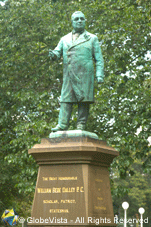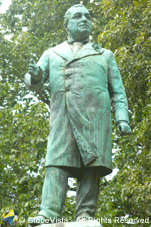William Bede Dalley Statue

Public Art: William Bede Dalley Statue
Nickname: The Green Man (because of his green patina)
Sculptor: © James White (2 December 1861 – 14 July 1918)
Date: Unveiled April 1897 by His Excellency the Governor, Lord Hampton.

Description: The lifesize bronze depicts a well-known lawyer and member of Parliament, William Dede Dalley, in his iconic buttoned coat, which he habitually wore. The statue stands on a polished granite pedestal supported on a tiered stone base. The statue is an example of a “lost wax” casting process, used for centuries and became popular during the Renaissance period (14th to 17th centuries) in Italy and France.
Funded: By Public Subscription
Location: The Green Man is located North East section of Hyde Park, Sydney, Australia.
Inscription :
The Right Honourable
William Bede Dalley P.C.
scholar, patriot,
statesman
Erected by Public Subscription
1897
Born in this city
Aug, 5th 1831
died
Oct, 28th 1888
Who was William Bede Dalley? So who is the mysterious “green man” who stands half-hidden amongst the trees of Hyde Park? William Bede Dalley was born in Sydney, George Street to be exact, on the 5th July, 1831. His Irish parents, John Dalley and Catherine Spillane had arrived in Australia as convicts.
A wonderful speechmaker, it wasn’t surprising that the short, thickset, jovial Dalley would seek a career in both law and politics. He was called to the bar in 1856 and the following year he was elected to the Legislative Assembly as one of the representatives of Sydney (City). In 1858, he successfully contested Cumberland Boroughs. In 1861 Dalley was appointed a commissioner of emigration by the New South Wales government and with fellow commissioner Henry Parkes, set sail to England for a year.
On his return he took up his legal practice again. His most prominent case as leading counsel was his defense of Irishman Henry James O’Farrell, who was the first man in Australia history to attempt a political assassination. The intended target was Prince Alfred, Duke of Edinburgh, the second son of Queen Victoria. O’Farrell came up behind the Prince during the Sailor’s Picnic in Clontarf, Sydney, and fired a revolver into his back. Luckily for the Prince six nurses trained by Florence Nightingale, had arrived in Australia the month before under Matron Lucy Osburn and nursed him back to health. Despite all efforts to get O’Farrell acquitted on the grounds of insanity he was found guilty and hanged.
In 1872 much to the horror of the Catholic church Dalley married an Anglican woman, Eleanor Jane Long. Sadly she died of typhoid fever 9 years later leaving Dalley with six young children. He left political life for several years to look after his family.
In 1875 Dalley became the Attorney-General of New South Wales and was nominated to the Legislative Council. In 1877 he became a Q.C.
Dalley was a renowned fashion trendsetter often seen dressed in colorful cravats and buttonholes. He loved hosting dinner party’s and would call friends and acquaintances alike ‘old boy’.
On 28th October 1888, Dalley died at his house, Annerly, Darling Point, from cardiac disease, renal disease, and uremia. As the country mourned a great Australian Patriot moves were already underway to erect a statue in his honour. The location, Hyde park, where the statue could look down Macquarie Street to the Law Courts and Parliament House.
Lord Carrington described William Bede Dalley as a man with “Tongue of silver, heart of gold.”
History of the William Bede Dalley Statue: When William Dalley died in 1888 a public subscription for a statue was initiated by colleagues and friends. A committee, lead by Sir John Robertson was set up and included the who’s who of Sydney’s business, legal, judicial, church and parliamentary elite, amongst them being Lieutenant Governor Sir Alfred Stephen and Chief Justice Sir Frederick Darley. Despite this, it still took nearly 10 years for the “green man” to be erected. The commission was given to the award-winning, James White, who, at his small foundry at Petersham, used the lost wax process to cast the statue.
Australian Apathy Controversy: William Bede Dally was a highly admired man and it wasn’t long after his statue was erected that complaints began mounting over the lack of respect shown in its upkeep. The location was highly criticised as being unbefitting of such a man, as the statue faced the side of the Coroners and Bankruptcy courts. The pedestal on which the statue stood had a huge crack in it and there was no railing or flower bed around it.
In 1905 a news article appeared in the Australian Star questioning the country’s lack of regards or care for monuments dedicated to Australian patriots and statemen. It used the William Bede Dalley statue as an example It reads in part.. .
As a result of the public movement a statue was erected in one of our city parks. But to what use has it descended?
Nothing but that a by-way and resting place for dirty, filthy loafers, who, when not in gaol, spend their time idly loafing around public parks, and sleeping on the steps of this edifice, scattering dirt and vermin about them. It is no uncommon site to see mangy mongrels sunning themselves at the foot of the statue, yet despite the numerous applications to have the statue properly railed and cleaned the trustees of the park always found some excuse for not remedying the defect.